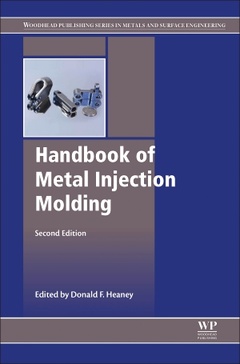Description
Handbook of Metal Injection Molding (2nd Ed.)
Woodhead Publishing Series in Metals and Surface Engineering Series
Coordinator: Heaney Donald F.
Language: English
Subjects for Handbook of Metal Injection Molding:
656 p. · 15x22.8 cm · Paperback
Description
/li>Contents
/li>Biography
/li>Comment
/li>
Metal injection molding combines the most useful characteristics of powder metallurgy and plastic injection molding to facilitate the production of small, complex-shaped metal components with outstanding mechanical properties. Handbook of Metal Injection Molding, Second Edition provides an authoritative guide to this important technology and its applications.
Building upon the success of the first edition, this new edition includes the latest developments in the field and expands upon specific processing technologies. Part one discusses the fundamentals of the metal injection molding process with chapters on topics such as component design, important powder characteristics, compound manufacture, tooling design, molding optimization, debinding, and sintering. Part two provides a detailed review of quality issues, including feedstock characterisation, modeling and simulation, methods to qualify a MIM process, common defects and carbon content control. Special metal injection molding processes are the focus of part three, which provides comprehensive coverage of micro components, two material/two color structures, and porous metal techniques. Finally, part four explores metal injection molding of particular materials, and has been expanded to include super alloys and precious metals.
With its distinguished editor and expert team of international contributors, the Handbook of Metal Injection Molding is an essential guide for all those involved in the high-volume manufacture of small precision parts, across a wide range of high-tech industries such as microelectronics, biomedical and aerospace engineering.
1. Metal powder injection molding (MIM): Key trends and markets 2. Applications for metal injection molding – firearm, medical, industrial, and automotive
Part 1 Processing 3. Designing for metal injection molding (MIM) 4. Powders for metal injection molding (MIM) 5. Powder binder formulation and compound manufacture in metal injection molding (MIM) 6. Commercially available feedstocks 7. Tooling for metal injection molding (MIM) 8. Molding of components in metal injection molding (MIM) 9. Debinding methods in metal injection molding (MIM) 10. Sintering methods for metal injection molding (MIM)
Part 2 Quality issues 11. Characterization of feedstock in metal injection molding (MIM) 12. Modeling and simulation of metal injection molding (MIM) 13. Common defects in metal injection molding (MIM) 14. Qualification of metal injection molding (MIM) 15. Control of carbon content in metal injection molding (MIM)
Part 3 Special metal injection molding processes 16. Micro metal injection molding (MicroMIM) 17. Automation of metal injection molding process 18. Two-material/two-colour powder metal injection molding (2C-PIM) 19. Powder space holder metal injection molding (PSH-MIM) of micro-porous metals 20. Metal injection molding of large components
Part 4 Metal injection molding of specific materials 21. Metal injection molding (MIM) of stainless steels 22. Metal injection molding (MIM) of titanium and titanium alloys 23. Metal injection molding (MIM) of thermal management materials in microelectronics 24. Metal injection molding (MIM) of soft magnetic materials 25. Metal injection molding (MIM) of high speed tool steels 26. Metal injection molding of heavy alloys, refractory metals, and hard metals 27. Metal injection molding of super alloys 28. Metal injection molding of carbon steels 29. Metal injection molding of precious metals 30. Metal injection molding of aluminum
- Provides an authoritative guide to metal injection molding and its applications
- Discusses the fundamentals of the metal injection molding processes and covers topics such as component design, important powder characteristics, compound manufacture, tooling design, molding optimization, debinding and sintering
- Comprehensively examines quality issues, such as feedstock characterization, modeling and simulation, common defects and carbon content control




